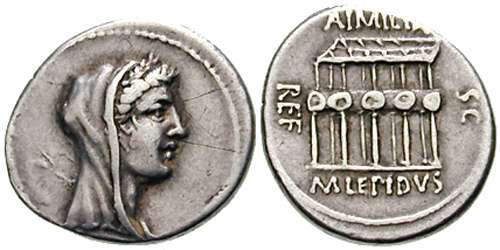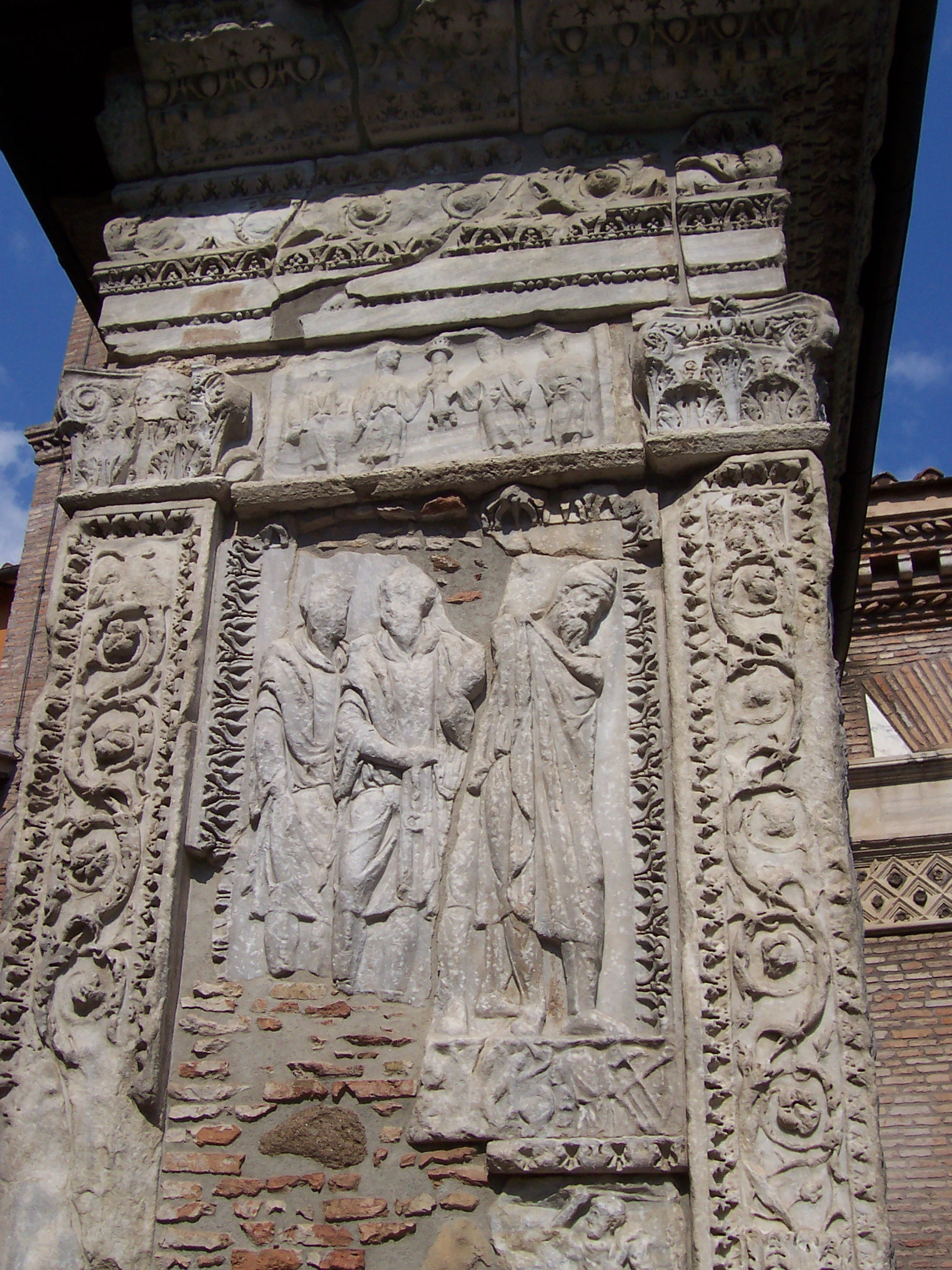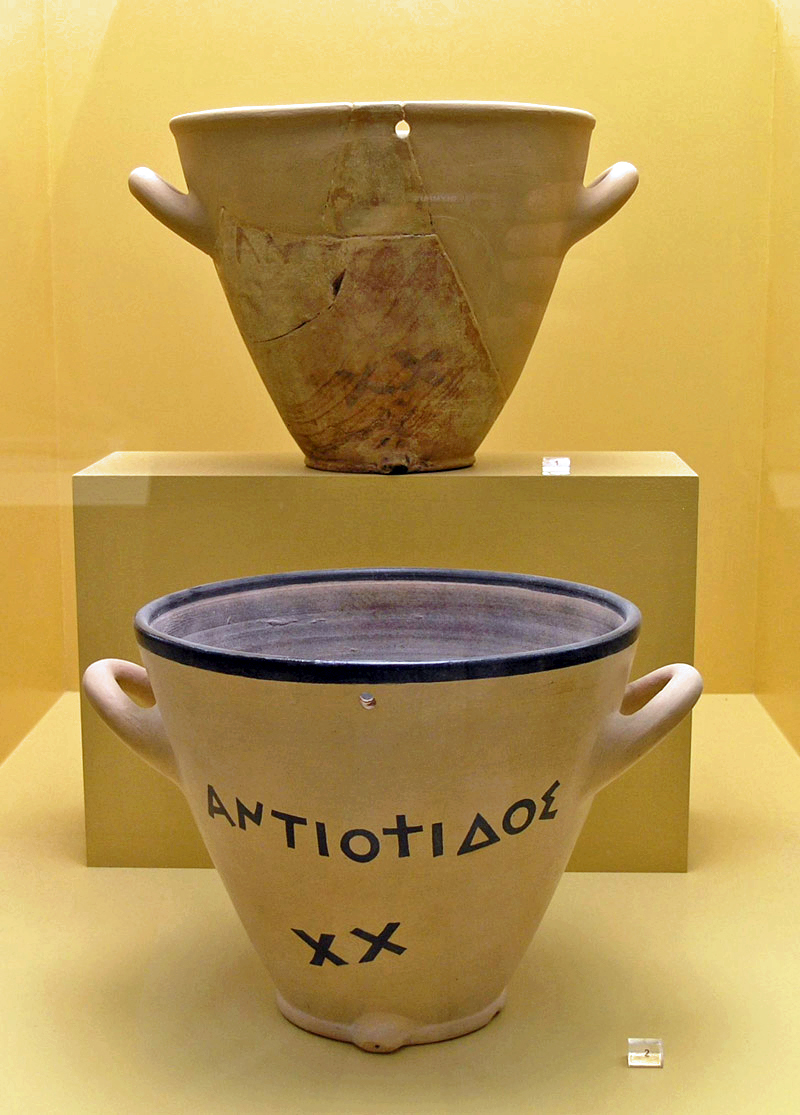|
Basilica Aemilia
The Basilica Aemilia (), or the Basilica Paulli, was a civil basilica in the Roman Forum. Lucius Aemilius Paullus initiated its construction, but the building was completed by his son, Paullus Aemilius Lepidus, in 34 BCE. Under Augustus, it was reconstructed in 22 CE and was described by Pliny as one of the most beautiful examples of Roman architecture. Today, only fragments of the floorplan and colonnade remain, but a continuous sculptural frieze from the lower entablature was partially reconstructed and is now preserved inside the neighboring Curia Julia. History Pre-existing structures According to Livy, a series of butcher shops ('' tabernae lanienae'') lined the central area of the Forum from the early Roman Republic era. Varro writes that by 310 BCE, the butchers had been relocated outside the Forum and their former storefronts were turned over to bankers ('' tabernae argentariae''). A fire in 210 BCE destroyed these '' tabernae'' and Livy refers to the newly built sho ... [...More Info...] [...Related Items...] OR: [Wikipedia] [Google] [Baidu] |
Regio IV Templum Pacis
The Regio IV Templum Pacis is the fourth 14 regions of Augustan Rome, regio of imperial Rome, under Augustus's administrative reform. Regio IV took its name from the Temple of Peace, Rome, Temple of Peace built in the region by the emperor Vespasian. It includes the valley between the Esquiline and the Viminal Hill, Viminal hills, the popular area of the Suburra, and the Velian Hill. Geographic extent and important features Although centred on the Temple of Peace, Rome, Temple of Peace within the Imperial Fora, Regio IV was cut in two by the Clivus Suburanus. To the north west, it was bordered by the Vicus Patricius, the Clivus Suburanus and the Servian Wall and included the Carinae. To the south east, it was bordered by the Colosseum and the Roman Forum, and included the Imperial fora and the Suburra. A measurement taken at the end of the 4th century recorded that the perimeter of the region was 13,000 Roman feet (approximately 3.84 km). When first organised by Augustus, R ... [...More Info...] [...Related Items...] OR: [Wikipedia] [Google] [Baidu] |
Banking In Ancient Rome
In ancient Rome there were a variety of officials tasked with banking. These were the ''argentarii'', ''mensarii'', ''coactores'', and ''nummulari''. The ''argentarii'' were money changers. The role of the ''mensarii'' was to help people through economic hardships, the ''coactores'' were hired to collect money and give it to their employer, and the ''nummulari'' minted and tested currency. They offered credit systems and loans. Between 260 and the fourth century AD, Roman bankers disappear from the historical record, likely because of economic difficulties caused by the debasement of the currency. History The earliest banks in ancient Rome were located in temples, as in the Etruscan civilization. They would charge interest on loans, exchange money, and track their finances through written records. Due to the piety of the officials and employees of these temples, the upper class of ancient Rome trusted these places to protect and hold their wealth. Typically, their money was st ... [...More Info...] [...Related Items...] OR: [Wikipedia] [Google] [Baidu] |
Aemilia Gens
The gens Aemilia, originally written Aimilia, was one of the greatest patrician families at ancient Rome. The gens was of great antiquity, and claimed descent from Numa Pompilius, the second King of Rome. Its members held the highest offices of the state, from the early decades of the Republic to imperial times.''Dictionary of Greek and Roman Biography and Mythology'', vol. I, p. 30 (" Aemilia Gens"). The Aemilii were almost certainly one of the ''gentes maiores'', the most important of the patrician families. Their name was associated with three major roads (the '' Via Aemilia'', the '' Via Aemilia Scauri'', and the '), an administrative region of Italy, and the Basilica Aemilia at Rome. Origin Several stories were told of the foundation of the Aemilii, of which the most familiar was that their ancestor, Mamercus, was the son of Numa Pompilius. In the late Republic, several other gentes claimed descent from Numa, including the Pompilii, Pomponii, Calpurnii, and Pina ... [...More Info...] [...Related Items...] OR: [Wikipedia] [Google] [Baidu] |
Publius Cornelius Scipio Nasica Serapio
Publius Cornelius Scipio Nasica Serapio (182 or 181 – 132 BC) was a Roman politician. He is most well known for mobilising the mob which killed Tiberius Gracchus, who was at the time attempting to stand for re-election as plebeian tribune in 133 BC. He was Roman consul, consul in 138 BC and served as pontifex maximus, from possibly 141 through to his death in 132 BC. Career Nasica's first known public office was that of military tribune, which T.R.S. Broughton provisionally dated to 149 BC in ''Magistrates of the Roman Republic''. If he held that office, he would have been an officer during the Third Punic War and the Siege of Carthage (Third Punic War), siege of Carthage. Alexander Yakobson, writing in the ''Encyclopedia of Ancient History'', tentatively identifies this Scipio with the one who committed a Political gaffe, gaffe when, during a canvass for the aedileship, he asked whether a farmer with rough hands had a habit of walking on his hands. ... [...More Info...] [...Related Items...] OR: [Wikipedia] [Google] [Baidu] |
Water Clock
A water clock, or clepsydra (; ; ), is a timepiece by which time is measured by the regulated flow of liquid into (inflow type) or out from (outflow type) a vessel, and where the amount of liquid can then be measured. Water clocks are some of the oldest time-measuring instruments. The simplest form of water clock, with a bowl-shaped outflow, existed in Babylon, Egypt, and Persia around the 16th century BC. Other regions of the world, including India and China, also provide early evidence of water clocks, but the earliest dates are less certain. Water clocks were used in ancient Greece and in ancient Rome, as described by technical writers such as Ctesibius (died 222 BC) and Vitruvius (died after 15 BC). Designs A water clock uses the flow of water to measure time. If viscosity is neglected, the physical principle required to study such clocks is Torricelli's law. Two types of water clock exist: inflow and outflow. In an outflow water clock, a container is filled with wate ... [...More Info...] [...Related Items...] OR: [Wikipedia] [Google] [Baidu] |
Marcus Aemilius Lepidus (consul 187 BC)
Marcus Aemilius Lepidus (c. 230 – 152 BC) was a Roman consul, Pontifex Maximus, Censor and Princeps Senatus. A scion of the ancient Patrician gens Aemilia, he was most likely the son of Marcus Aemilius Lepidus, with his brothers being Lucius and Quintus. According to Polybius, Lepidus was "the handsomest man of his time," as well as, in the words of Diodorus, being "gifted with superior intelligence". Combining these qualities with an impeccable aristocratic birth, political skill and a reputation for bravery, Lepidus soon rose to become one of the leading Romans of his generation. Lepidus was the great-grandfather of Marcus Aemilius Lepidus the Triumvir. Early life Although he was only 15 at the time of the Battle of Cannae in the 2nd Punic War, it was then that Lepidus first distinguished himself. If not at Cannae itself, then in one of the battles closely following it, Lepidus saved the life of one of his countrymen by killing his assailant. For this act of ga ... [...More Info...] [...Related Items...] OR: [Wikipedia] [Google] [Baidu] |
Roman Consul
The consuls were the highest elected public officials of the Roman Republic ( to 27 BC). Romans considered the consulship the second-highest level of the ''cursus honorum''an ascending sequence of public offices to which politicians aspiredafter that of the Roman censor, censor, which was reserved for former consuls. Each year, the Centuriate Assembly elected two consuls to serve jointly for a one-year term. The consuls alternated each month holding ''fasces'' (taking turns leading) when both were in Rome. A consul's ''imperium'' (military power) extended over Rome and all its Roman provinces, provinces. Having two consuls created a check on the power of any one individual, in accordance with the republican belief that the powers of the former King of Rome, kings of Rome should be spread out into multiple offices. To that end, each consul could veto the actions of the other consul. After the establishment of the Roman Empire, Empire (27 BC), the consuls became mere symboli ... [...More Info...] [...Related Items...] OR: [Wikipedia] [Google] [Baidu] |
Aemilia26
Aemilia may refer to: People and places in classical history * Aemilia (gens), patrician family of ancient Rome, and the female members of this ''gens'' * Aemilia Tertia (c. 230–163 or 162 BC), third daughter of Lucius Aemilius Paullus, and wife of Scipio Africanus * Aemilia Hilaria (c. 300–c. 363), ancient Roman physician * Aemilia Lepida, any of several female members of the gens Aemilia * Emilia (region of Italy) * Via Aemilia, a Roman road Other uses * ''Aemilia'' (moth) * 159 Aemilia, an asteroid * Dutch ship ''Aemilia'' (1632), a Dutch ship of the line See also * * Emily (given name) * Emilia (given name) Emilia is a feminine Italian language, Italian given name of Latin origin. The name is popular all over Europe and the Americas. The corresponding masculine name is Emilio_(given_name), Emilio. Emily_(given_name), Emily is the English form of the I ... {{disambig, given name Feminine given names ... [...More Info...] [...Related Items...] OR: [Wikipedia] [Google] [Baidu] |
Forum Piscarium
The Forum Piscarium () was the fish market of ancient Rome (a ''forum venalium''), north of the Roman Forum, between the Sacra Via and the Argiletum. It was burned in 210 BC and rebuilt the next year. In 179 BC it was incorporated in the general Macellum, built by Marcus Fulvius Nobilior in the same region. This forum is called ''piscatorium'' in Livy, and ''piscarium'' in Varro and Plautus Titus Maccius Plautus ( ; 254 – 184 BC) was a Roman playwright of the Old Latin period. His comedies are the earliest Latin literary works to have survived in their entirety. He wrote Palliata comoedia, the genre devised by Livius Andro ... (Curc. 474). References Lacus Curtius - Forums of Ancient Rome Buildings and structures completed in the 3rd century BC Piscarium {{AncientRome-struct-stub ... [...More Info...] [...Related Items...] OR: [Wikipedia] [Google] [Baidu] |
Monteverde, Campania
Monteverde is a ''comune'' in the province of Avellino in Southern Italy. It is one of I Borghi più belli d'Italia ("The most beautiful villages of Italy"). History In the 11th century, Monteverde became a bishopric seat and had a bishop until 1531, when the diocese of Monteverde was merged with the diocese of Canne. From 1532 to 1641, it was a baronial seigniory In English law, seignory or seigniory, spelled ''signiory'' in Early Modern English (; ; ), is the lordship (authority) remaining to a grantor after the grant of an estate in fee simple. '' Nulle terre sans seigneur'' ("No land without a lord") ..., held by a branch of the Grimaldi family. The diocese was eventually cancelled in 1818. References Cities and towns in Campania Borghi più belli d'Italia {{Campania-geo-stub ... [...More Info...] [...Related Items...] OR: [Wikipedia] [Google] [Baidu] |
Shrine Of Venus Cloacina
The Shrine of Venus Cloacina (''Sacellum Cloacinae'' or ''Sacrum Cloacina'') was a small sanctuary on the Roman Forum, honoring the divinity of the ''Cloaca Maxima'', the "Great Drain" or sewer of Rome. Cloacina, the Etruscan civilization, Etruscan goddess associated with the entrance to the sewer system, was later identified with the Roman goddess Venus (mythology), Venus for unknown reasons, according to Pliny the Elder. History The foundation and cult of the shrine was associated in Roman mythology, Roman legend with the Sabine king Titus Tatius, who ruled during the time of Romulus (8th century BC). The Etruscan deity Cloacina may have been associated originally with the small brook which marked the boundary between the Sabines on the Quirinal Hill and Romans on the Palatine Hill and later became the city's ''Cloaca Maxima''. Two important episodes from Rome's founding are said to have taken place at this shrine, including the purification of the Sabine and Roman armies aft ... [...More Info...] [...Related Items...] OR: [Wikipedia] [Google] [Baidu] |
Plautus
Titus Maccius Plautus ( ; 254 – 184 BC) was a Roman playwright of the Old Latin period. His comedies are the earliest Latin literary works to have survived in their entirety. He wrote Palliata comoedia, the genre devised by Livius Andronicus, the innovator of Latin literature. The word Plautine () refers to both Plautus's own works and works similar to or influenced by his. Biography Not much is known about Titus Maccius Plautus's early life. It is believed that he was born in Sarsina, a small town in Emilia Romagna in northern Italy, around 254 BC.''The Concise Oxford Companion to Classical Literature'' (1996) Ed. M.C. Howatson and Ian Chilvers, Oxford University Press, Oxford Reference Online According to Morris Marples, Plautus worked as a stage-carpenter or scene-shifter in his early years. It is from this work, perhaps, that his love of the theater originated. His acting talent was eventually discovered; and he adopted the nomen "Maccius" (from Maccus, a clownis ... [...More Info...] [...Related Items...] OR: [Wikipedia] [Google] [Baidu] |





